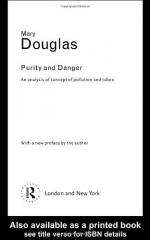|
This section contains 328 words (approx. 1 page at 400 words per page) |

|
Purity and Danger: An Analysis of Concepts of Pollution and Taboo Summary & Study Guide Description
Purity and Danger: An Analysis of Concepts of Pollution and Taboo Summary & Study Guide includes comprehensive information and analysis to help you understand the book. This study guide contains the following sections:
This detailed literature summary also contains Topics for Discussion and a Free Quiz on Purity and Danger: An Analysis of Concepts of Pollution and Taboo by Mary Douglas.
Purity and Danger by Mary Douglas deals with primitive and modern cultures, exploring various ways they organize their social life through specific approaches to rituals, dirt, and pollution.
Prejudice towards primitive cultures as inferior can be attributed to previous approaches dealing with common patterns among them rather than their social structures. The initial views that primitive cultures display fear and lack of understanding because they have to deal with the immediacy of their environment have been discarded. Through their approach to hygiene and pollution, both external and internal community structures are examined. Most cultures have means of protection of their social order through classification and preservation of purity. Food classification and purity is the foremost element in maintaining such purity as part of health, completeness, and holiness. Primitive cultures engage a personal view of the universe that is apt to intervene in their affairs.
Dirt represents danger through disorder that is formless in nature and has the ability to change boundaries. Such boundaries need to be protected from unwarranted entering, where purity ensures the preservation of social order. The boundaries to castes are protected through enforcing virginity and careful restriction of those that can access specific castes while they also reflect various functions of the body, ranging from cleaners to leaders. Society and social order are endangered by transitional and marginal states.
As dirt represents power and creativity, purity stands for rigidity and lack of change. Pollution and dirt form power that can only be harnessed through rituals. Despite the rejection of dirt and pollution by most religions, primitive religions unveil that through paradox and contradiction dirt is needed as part of replacing what has been rejected, incorporating the process of renewal. The necessity of death requires both its rejection and confrontation. These practices expose a realistic approach to life by primitive cultures, who view the world in a unified way where cosmic forces preserve and maintain the social order as part of nature.
Read more from the Study Guide
|
This section contains 328 words (approx. 1 page at 400 words per page) |

|



